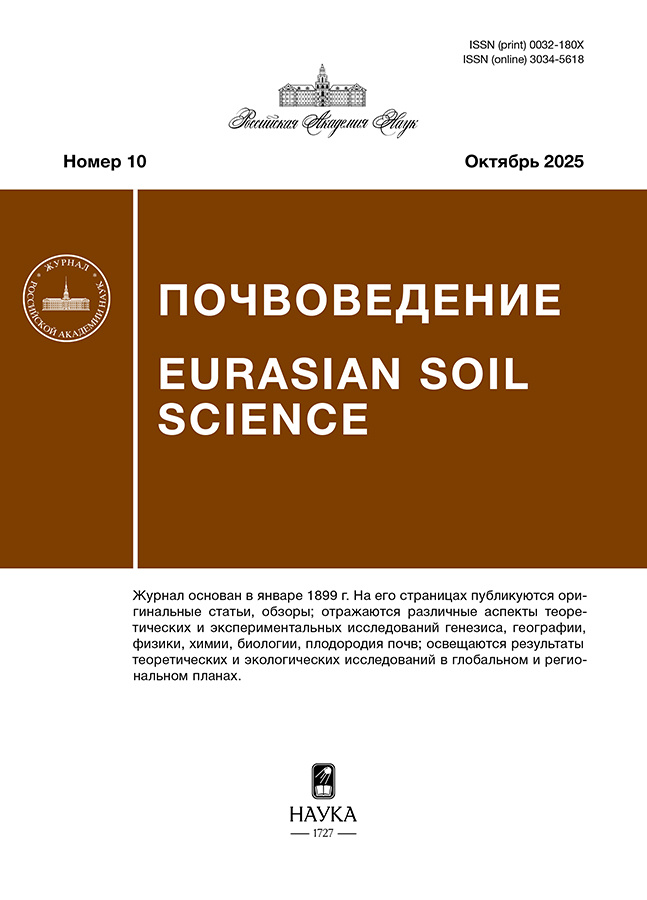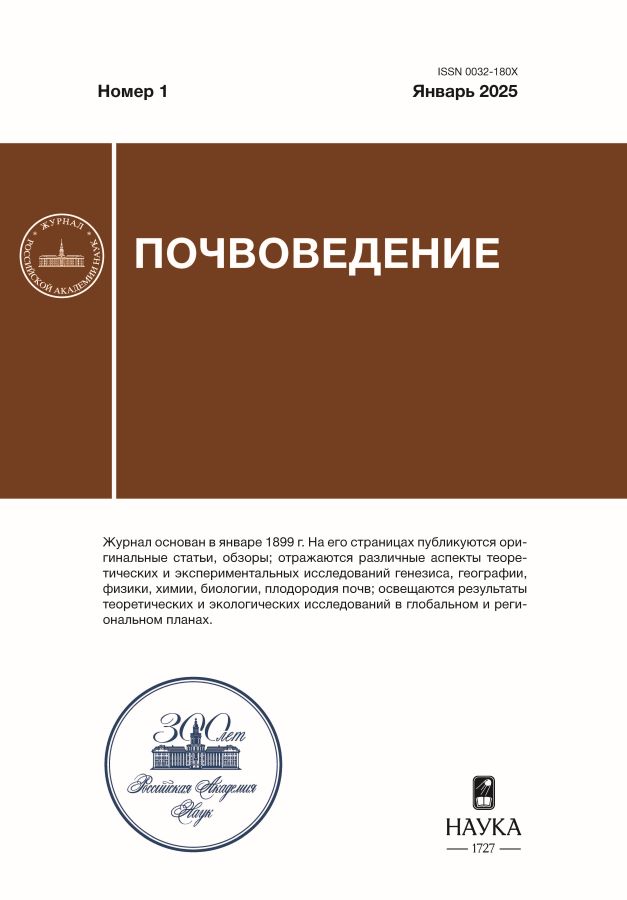Метаболом черноземов типичных различного вида использования
- Авторы: Фарходов Ю.Р.1, Куликова Н.А.2, Данченко Н.Н.1, Белобров В.П.1, Ярославцева Н.В.1, Лазарев В.И.3, Крысанов С.А.4, Холодов В.А.1
-
Учреждения:
- Почвенный институт им. В.В. Докучаева
- МГУ им. М.В. Ломоносова
- Курский федеральный аграрный научный центр
- Северный (Арктический) федеральный университет им. М.В. Ломоносова
- Выпуск: № 1 (2025)
- Страницы: 92–101
- Раздел: ХИМИЯ ПОЧВ
- URL: https://kld-journal.fedlab.ru/0032-180X/article/view/680011
- DOI: https://doi.org/10.31857/S0032180X25010073
- EDN: https://elibrary.ru/BXWEUP
- ID: 680011
Цитировать
Полный текст
Аннотация
Исследовано влияние землепользования на формирование метаболома чернозема типичного. Проанализированы черноземы типичные (Haplic Chernozems) многолетних полевых опытов Курского ФАНЦ (пос. Черемушки, Курская область) четырех видов использования: 55-летний бессменный черный пар, 21-летняя залежь после бессменного черного пара, 4-летние полевые опыты с применением технологии прямого посева и традиционной обработки. Для изучения почвенного метаболома проводили водную экстракцию фумигированной и нефумигированной почвы с последующим определением содержания водоэкстрагируемого органического углерода (Свэ) и углерода микробной биомассы (Смик) методом высокотемпературного каталитического окисления, а также состава почвенных метаболитов методом газовой хроматографии с масс-спектрометрией. На примере залежи продемонстрировано влияние постагрогенной трансформации черноземов на накопление лабильных форм почвенного углерода. Вспашка черноземов в условиях отсутствия поступления растительного опада приводит к сокращению содержания лабильного углерода. На уровне тенденции показан положительный эффект прямого посева на содержание лабильных форм углерода. По результатам метаболомного анализа черноземов идентифицировано 21 соединение, участвующее в метаболизме углеводов, липидов и азотистых веществ. С помощью индекса разнообразия Шеннона продемонстрировано негативное влияние вспашки на сложность метаболомных профилей черноземов. Наиболее контрастные различия в метаболитном составе выявлены между черноземами, находящимися под залежью и паром, которые обусловлены преобладанием вкладов метаболитов растительного и микробного происхождения соответственно. Наблюдается тенденция к накоплению метаболитов растительного происхождения в черноземе, формирующемся в условиях применения прямого посева. Установлено, что в метаболомном профиле пахотных черноземов доминируют компоненты углеводного обмена, а в непахотных – компоненты азотистого и липидного обмена.
Ключевые слова
Полный текст
Открыть статью на сайте журналаОб авторах
Ю. Р. Фарходов
Почвенный институт им. В.В. Докучаева
Автор, ответственный за переписку.
Email: yulian.farkhodov@yandex.ru
ORCID iD: 0000-0002-0210-380X
Россия, Пыжевский пер., 7, стр. 2, Москва, 119017
Н. А. Куликова
МГУ им. М.В. Ломоносова
Email: yulian.farkhodov@yandex.ru
Россия, Ленинские горы, 1, Москва, 119991
Н. Н. Данченко
Почвенный институт им. В.В. Докучаева
Email: yulian.farkhodov@yandex.ru
Россия, Пыжевский пер., 7, стр. 2, Москва, 119017
В. П. Белобров
Почвенный институт им. В.В. Докучаева
Email: yulian.farkhodov@yandex.ru
Россия, Пыжевский пер., 7, стр. 2, Москва, 119017
Н. В. Ярославцева
Почвенный институт им. В.В. Докучаева
Email: yulian.farkhodov@yandex.ru
Россия, Пыжевский пер., 7, стр. 2, Москва, 119017
В. И. Лазарев
Курский федеральный аграрный научный центр
Email: yulian.farkhodov@yandex.ru
Россия, ул. Карла Маркса, 70Б, Курск, 305021
С. А. Крысанов
Северный (Арктический) федеральный университет им. М.В. Ломоносова
Email: yulian.farkhodov@yandex.ru
Россия, набережная Северной Двины, 17, Архангельск, 163002
В. А. Холодов
Почвенный институт им. В.В. Докучаева
Email: yulian.farkhodov@yandex.ru
Россия, Пыжевский пер., 7, стр. 2, Москва, 119017
Список литературы
- Воробьева Л.А. Теория и практика химического анализа почв. М.: ГЕОС, 2006. 400 с.
- Гончаров Н.В., Уколов А.И., Орлова Т.И., Мигаловская Е.Д., Войтенко Н.Г. Метаболомика: на пути интеграции биохимии, аналитической химии, информатики // Успехи современной биологии. 2015. Т. 135. № 1. С. 3–17.
- Евдокимов И.В. Методы определения биомассы почвенных микроорганизмов // Russian Journal of Ecosystem Ecology. 2018. № 3. С. 1–20. https://doi.org/10.21685/2500-0578-2018-3-5
- Классификация и диагностика почв России. Смоленск: Ойкумена, 2004. 342 с.
- Корчагин А.А., Мазиров М.А., Щукин И.М. Общее земледелие: учебное пособие. Владимир: Изд-во ВлГУ, 2021. 193 с.
- Никитин Д.А., Иванова Е.А., Железова А.Д., Семенов М.В., Гаджиумаров Р.Г., Тхакахова А.К., и др. Оценка влияния технологии no-till и вспашки на микробиом южных агрочерноземов // Почвоведение. 2020. № 12. С. 1508–1520.
- Полянская Л.М., Суханова Н.И., Чакмазян К.В., Звягинцев Д.Г. Особенности изменения структуры микробной биомассы почв в условиях залежи // Почвоведение. 2012. № 7. С. 792–792.
- Фрунзе Н.И. Разнообразие аминокислот чернозема типичного (Молдавия) // Почвоведение. 2014. № 12. С. 1483–1489.
- Холодов В.А., Фарходов Ю.Р., Ярославцева Н.В., Айдиев А.Ю., Лазарев В.И., Ильин Б.С., и др.. Термолабильное и термостабильное органическое вещество черноземов разного землепользования // Почвоведение. 2020. № 8. С. 970–982. https://doi.org/10.31857/S0032180X20080080
- Холодов В.А., Ярославцева Н.В. Агрегаты и органическое вещество почв восстанавливающихся ценозов. М.: ГЕОС, 2021. 119 с.
- Холодов В.А., Фарходов Ю.Р., Ярославцева Н.В., Данченко Н.Н., Ильин Б.С., Лазарев В.И. Водоэкстрагируемый и микробный углерод черноземов разного вида использования // Бюл. Почв. ин-та им В.В. Докучаева. 2022. № 112. С. 122–133. https://doi.org/10.19047/0136-1694-2022-112-122-133
- Aksenov A.A., Laponogov I., Zhang Z., Doran S.L.F., Belluomo I., Veselkov D., et al. Auto-deconvolution and molecular networking of gas chromatography–mass spectrometry data // Nature Biotechnology. 2021. V. 39. № 2. P. 169–173. https://doi.org/10.1038/s41587-020-0700-3
- Chantigny M.H. Dissolved and water-extractable organic matter in soils: a review on the influence of land use and management practices // Geoderma. 2003. V. 113. № 3. P. 357–380. https://doi.org/10.1016/S0016-7061(02)00370-1
- Cheng H., Yuan M., Tang L., Shen Y., Yu Q., Li S. Integrated microbiology and metabolomics analysis reveal responses of soil microorganisms and metabolic functions to phosphorus fertilizer on semiarid farm // Sci. Total Environ. 2022. V. 817. P. 152878. https://doi.org/10.1016/j.scitotenv.2021.152878
- Chinou I. Primary and secondary metabolites and their biological activity // Chromatographic Sci. Series. 2008. V. 99. P. 59.
- Domingues R., Bondar M., Palolo I., Queirós O., de Almeida C.D., Cesário M.T. Xylose Metabolism in Bacteria–Opportunities and Challenges towards Efficient Lignocellulosic Biomass-Based Biorefineries // Appl. Sci. 2021. V. 11. № 17. P. 8112. https://doi.org/10.3390/app11178112
- Elbein A.D., Pan Y.T., Pastuszak I., Carroll D. New insights on trehalose: a multifunctional molecule // Glycobiology. 2003. V. 13. № 4. P. 17R–27R. https://doi.org/10.1093/glycob/cwg047
- Fischer H., Meyer A., Fischer K., Kuzyakov Y. Carbohydrate and amino acid composition of dissolved organic matter leached from soil // Soil Biol. Biochem. 2007. V. 39. № 11. P. 2926–2935. https://doi.org/10.1016/j.soilbio.2007.06.014
- Gancedo C. Energy-yielding metabolism // The yeasts. 1989. V. 3. P. 205–259.
- Gunina A., Kuzyakov Y. Sugars in soil and sweets for microorganisms: Review of origin, content, composition and fate // Soil Biol. Biochem. 2015. V. 90. P. 87–100. https://doi.org/10.1016/j.soilbio.2015.07.021
- Helgason B.L., Walley F.L., Germida J.J. Fungal and Bacterial Abundance in Long-Term No-Till and Intensive-Till Soils of the Northern Great Plains // Soil Sci. Soc. Am. J. 2009. V. 73. № 1. P. 120–127. https://doi.org/10.2136/sssaj2007.0392
- Hollywood K., Brison D.R., Goodacre R. Metabolomics: Current technologies and future trends // PROTEOMICS. 2006. V. 6. № 17. P. 4716–4723. https://doi.org/10.1002/pmic.200600106
- ISO 8245. Water quality–guidelines for the determination of total organic carbon (TOC) and dissolved organic carbon (DOC). 1999.
- ISO 10694:1995 – Soil quality – Determination of organic and total carbon after dry combustion (elementary analysis). 1995.
- Iturriaga G., Suárez R., Nova-Franco B. Trehalose Metabolism: From Osmoprotection to Signaling // Int. J. Molecular Sci. 2009. V. 10. № 9. P. 3793–3810. https://doi.org/10.3390/ijms10093793
- Jones O.A.H., Maguire M.L., Griffin J.L., Dias D.A., Spurgeon D.J., Svendsen C. Metabolomics and its use in ecology // Austral Ecology. 2013. V. 38. № 6. P. 713–720. https://doi.org/10.1111/aec.12019
- Kind T., Wohlgemuth G., Lee D.Y., Lu Y., Palazoglu M., Shahbaz S., et al. FiehnLib: Mass Spectral and Retention Index Libraries for Metabolomics Based on Quadrupole and Time-of-Flight Gas Chromatography/Mass Spectrometry // Anal. Chem. 2009. V. 81. № 24. P. 10038–10048. https://doi.org/10.1021/ac9019522
- Li M., He P., Guo X.-L., Zhang X., Li L.-J. Fifteen-year no tillage of a Mollisol with residue retention indirectly affects topsoil bacterial community by altering soil properties // Soil Till. Res. 2021. V. 205. P. 104804. https://doi.org/10.1016/j.still.2020.104804
- Liu K., Ding X., Wang J. Soil metabolome correlates with bacterial diversity and co-occurrence patterns in root-associated soils on the Tibetan Plateau // Sci. Total Environ. 2020. V. 735. P. 139572. https://doi.org/10.1016/j.scitotenv.2020.139572
- Misra B.B. Data normalization strategies in metabolomics: Current challenges, approaches, and tools // Eur. J. Mass Spectrometry. 2020. V. 26. № 3. P. 165–174. https://doi.org/ 10.1177/1469066720918446
- Miura M., Hill P.W., Jones D.L. Impact of a single freeze-thaw and dry-wet event on soil solutes and microbial metabolites // Appl.Soil Ecology. 2020. V. 153. P. 103636. https://doi.org/10.1016/j.apsoil.2020.103636
- Oades J.M. Soil organic matter and structural stability: mechanisms and implications for management // Plant and Soil. 1984. V. 76. № 1. P. 319–337. https://doi.org/10.1007/BF02205590
- Patel A., Patel N., Ali A., Alim H. Chapter 4 – Metabolic engineering of plant primary–secondary metabolism interface // Genomics, Transcriptomics, Proteomics and Metabolomics of Crop Plants. Academic Press, 2023. P. 69–87. https://doi.org/10.1016/B978-0-323-95989-6.00015-2
- R Core Team. R: A language and environment for statistical computing. R Foundation for Statistical Computing, Vienna, Austria. 2022. https://www.R-project.org/
- Reina-Bueno M., Argandoña M., Nieto J.J., Hidalgo-García A., Iglesias-Guerra F., Delgado M.J., et al. Role of trehalose in heat and desiccation tolerance in the soil bacterium Rhizobium etli // BMC Microbiology. 2012. V. 12. № 1. P. 207. https://doi.org/10.1186/1471-2180-12-207
- Rochfort S., Ezernieks V., Mele P., Kitching M. NMR metabolomics for soil analysis provide complementary, orthogonal data to MIR and traditional soil chemistry approaches – a land use study // Magnetic Resonance in Chemistry. 2015. V. 53. № 9. P. 719–725. https://doi.org/10.1002/mrc.4187
- Romero C.M., Engel R.E., D’Andrilli J., Chen C., Zabinski C., Miller P.R., et al. Bulk optical characterization of dissolved organic matter from semiarid wheat-based cropping systems // Geoderma. 2017. V. 306. P. 40–49. https://doi.org/10.1016/j.geoderma.2017.06.029
- Samson M.-E., Chantigny M.H., Vanasse A., Menasseri-Aubry S., Royer I., Angers D.A. Management practices differently affect particulate and mineral-associated organic matter and their precursors in arable soils // Soil Biol. Biochem. 2020. V. 148. P. 107867. https://doi.org/10.1016/j.soilbio.2020.107867
- Song Y., Yao S., Li X., Wang T., Jiang X., Bolan N. et al. Soil metabolomics: Deciphering underground metabolic webs in terrestrial ecosystems // Eco-Environment Health. 2024. V. 3. № 2. P. 227–237. https://doi.org/10.1016/j.eehl.2024.03.001
- Swenson T.L., Jenkins S., Bowen B.P., Northen T.R. Untargeted soil metabolomics methods for analysis of extractable organic matter // Soil Biol. Biochem. 2015. V. 80. P. 189–198. https://doi.org/10.1016/j.soilbio.2014.10.007
- Toosi E.R., Castellano M.J., Singer J.W., Mitchell D.C. Differences in Soluble Organic Matter After 23 Years of Contrasting Soil Management // Soil Sci. Soc. Am. J. 2012. V. 76. № 2. P. 628–637. https://doi.org/10.2136/sssaj2011.0280
- Vance E.D., Brookes P.C., Jenkinson D.S. An extraction method for measuring soil microbial biomass C // Soil Biol. Biochem. 1987. V. 19. № 6. P. 703–707. https://doi.org/10.1016/0038-0717(87)90052-6
- Warren C.R. Response of osmolytes in soil to drying and rewetting // Soil Biol. Biochem. 2014. V. 70. P. 22–32. https://doi.org/10.1016/j.soilbio.2013.12.008
- Warren C.R., Manzoni S. When dry soil is re-wet, trehalose is respired instead of supporting microbial growth // Soil Biol. Biochem. 2023. V. 184. P. 109121. https://doi.org/10.1016/j.soilbio.2023.109121
- World Reference Base for Soil Resources 2014, International soil classification system for naming soils and creating legends for soil maps Rome: FAO, 2015. 203 p.
- Xu L., Jin S., Su Y., Lyu X., Yan S., Wang C., et al. Combined metagenomics and metabolomic analysis of microbial community structure and metabolic function in continuous soybean cropping soils of Songnen Plain, China // Chemical and Biological Technologies in Agriculture. 2024. V. 11. № 1. P. 46. https://doi.org/10.1186/s40538-024-00569-x
- Yao S., Bian Y., Jiang X., Song Y. Characterization of dissolved organic matter distribution in forestland and farmland of mollisol based on untargeted metabolomics // Soil Ecology Lett. 2023. V. 5. № 4. P. 230179. https://doi.org/10.1007/s42832-023-0179-1
- Zhang A., Sun H., Xu H., Qiu S., Wang X. Cell metabolomics // Omics. 2013. V. 17. № 10. P. 495-501. https://doi.org/10.1089/omi.2012.0090
- Zhang J., Zhou D., Yuan X., Xu Y., Chen C., Zhao L. Soil microbiome and metabolome analysis reveals beneficial effects of ginseng–celandine rotation on the rhizosphere soil of ginseng-used fields // Rhizosphere. 2022. V. 23. P. 100559. https://doi.org/10.1016/j.rhisph.2022.100559
- Zhao Y., Yao Y., Xu H., Xie Z., Guo J., Qi Z., et al. Soil metabolomics and bacterial functional traits revealed the responses of rhizosphere soil bacterial community to long-term continuous cropping of Tibetan barley // PeerJ. 2022. V. 10. P. e13254. https://doi.org/10.7717/peerj.13254
- Zheng F., Wu X., Zhang M., Liu X., Song X., Lu J., et al. Linking soil microbial community traits and organic carbon accumulation rate under long-term conservation tillage practices // Soil Till. Res. 2022. V. 220. P. 105360.https://doi.org/10.1016/j.still.2022.105360
- Zuber S.M., Villamil M.B. Meta-analysis approach to assess effect of tillage on microbial biomass and enzyme activities // Soil Biol. Biochem. 2016. V. 97. P. 176–187. https://doi.org/10.1016/j.soilbio.2016.03.011
Дополнительные файлы














